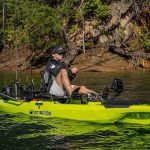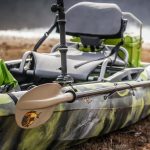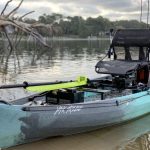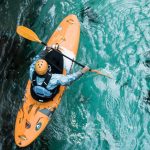Inflatable fishing kayaks are becoming more popular every year. But are they good? We've busted some myths about inflatables and picked some great models for you.
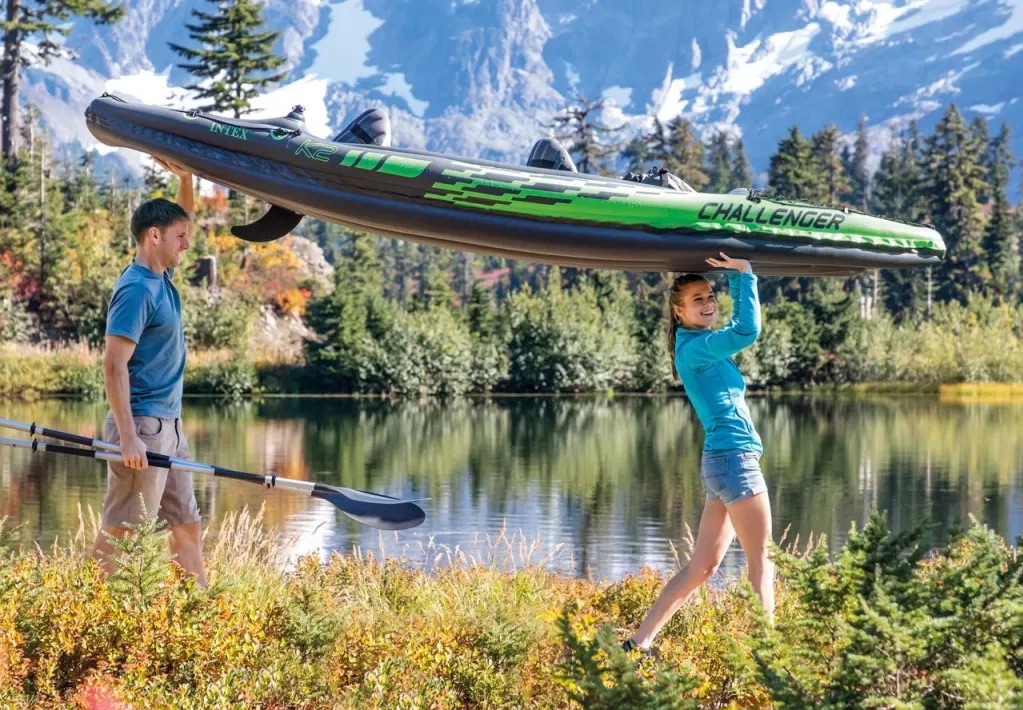
In a hurry? Our pick as the best inflatable kayak for 2023 is ADVANCED ELEMENTS AdvancedFrame
Inflatable kayaks are absolutely game-changing—and this past summer, my wife and I discovered just how much!
At the end of a long work day, all we had to do was throw our kayaks into the trunk of our sedan (no truck or SUV with roof racks needed!) and zip out to the nearest lake 20 minutes from our house. From there, it took all of 10 minutes to get the kayaks pumped up and out on the water.
How amazing is that?
Inflatable kayaks are the ideal solution for any busy working parents or professionals who want a quick and easy option for kayaking anytime, anywhere. Thanks to the fact that they fold up beautifully small (seriously, no larger than a piece of luggage), they’ll fit in any car trunk, and offer you an awesomely portable watercraft that can travel with you everywhere you go. ‘
In this post, I’ll share with you all of the best inflatable kayaks on the market—singles, tandems, fishing, recreational, and even sit-on-top kayaks.
Plus, I’ll get into the important factors to consider when going kayak-shopping and help you choose from among the many inflatable kayaks on the market to narrow down your options to the best one.
By the end of this post, you’ll be ready to select the right inflatable kayak for your next summer adventure!
As an affiliate of Amazon and other retailers, we may earn a small commission when you buy via our links, at no additional cost to you. Thank you!
Quick Answer: The Best Inflatable Kayaks for 2023
Don’t have time to read the whole article? Check out our condensed list to find the best inflatable kayak for your specific needs:
- Best Overall: ADVANCED ELEMENTS AdvancedFrame
- Best Budget: Intex Challenger K1
- Best Budget Tandem: Sea Eagle 370 Pro
- Best Single Recreational: Intex Excursion Pro
- Best for Fishing: Aquaglide Blackfoot Angler 130
- Best Tandem Fishing: Elkton Outdoors Cormorant
- Best Hybrid: ISLE Switch
- Best for the Beach: ADVANCED ELEMENTS Lagoon 1
- Best Sit-on-Top: Sevylor Quikpak K1
Comparison Table: Best Inflatable Kayaks
| Model | Specs | Where To Buy |
ADVANCED ELEMENTS AdvancedFrame | Size: 10’ 5” x 32″ Weight: 36 lbs. Capacity: 300 lbs. | Amazon |
Intex Challenger K1 | Size: 9’ x 30″ Weight: 27.2 lbs. Capacity: 220 lbs. | Amazon |
Sea Eagle 370 Pro | Size: 12’6″ x 33.8″ Weight: 33 lbs Capacity: 650 lbs | Amazon |
Intex Excursion Pro | Size: 10’ x 36″ Weight: 37.29 lbs. Capacity: 220 lbs. | Amazon |
Aquaglide Blackfoot Angler 130 | Size: 13’ x 38″ Weight: 41 lbs. Capacity: 650 lbs. | REI |
 Elkton Outdoors Cormorant | Size: 10’ x 35 ” Weight: 27 lbs. Capacity: 450 lbs. | Amazon |
ISLE Switch | Size: 11’ 6” x 35.5″ Weight: 19 lbs. Weight Capacity: 425 lbs. | Amazon |
 ADVANCED ELEMENTS Lagoon 1 | Size: 8’ 4” x 34″ Weight: 23 lbs. Capacity: 250 lbs. | Amazon |
 Sevylor Quikpak K1 | Size: 8’7” x 3’ Weight: 18 lb Capacity: 400 lb | Amazon |
Best Inflatable Kayak Reviews
Best Overall: ADVANCED ELEMENTS AdvancedFrame
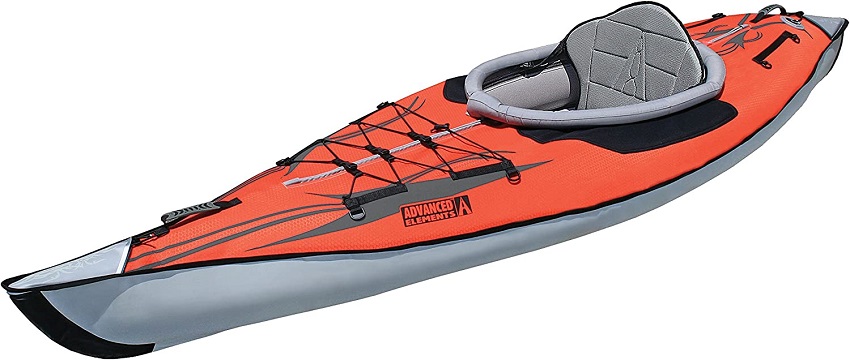
Length: 10’ 5” (318 cm)
Width: 32″ (82 cm)
Weight: 36 lbs. (16 kg)
Weight Capacity: 300 lbs. (136 kg)
Construction: Triple-layered PVC with integrated aluminum rib
If you’re looking for an ultra-sturdy inflatable kayak, look no further than the Advanced Elements AdvancedFrame! What makes this one so unique is the fact that in addition to triple-layered PVC (which combines polyester and vinyl), the kayak comes with aluminum ribs that add rigidity and durability. On top of that, it also features rigid panels and multiple chambers that make it feel and function more like a hardshell kayak than an inflatable.
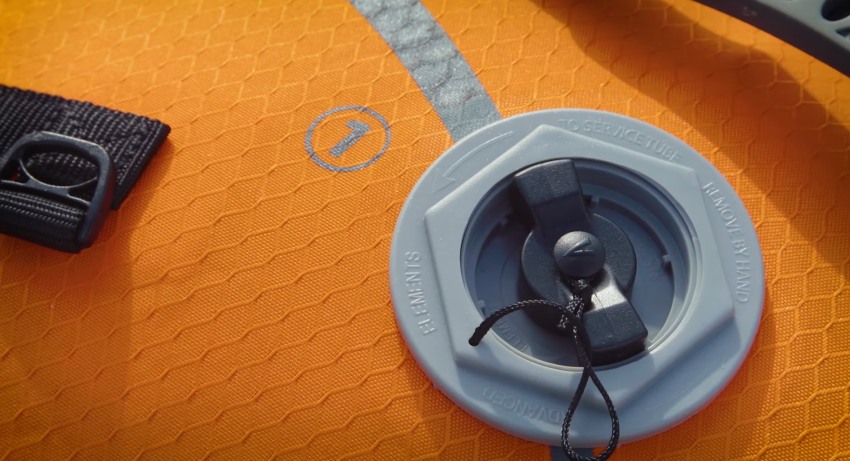
Price-wise, it’s definitely on the upper end for an inflatable kayak, but well worth it if you’re looking for performance and handling as well as portability. Though it’s got a lower-than-average weight capacity—just 300 pounds—it’s light enough (at 36 pounds) that anyone can carry it to and from the water.
The main downside of this bad boy is that it’s so popular it’s often sold out. However, when it’s available—both in solo and tandem designs—it’s absolutely worth the purchase.
Best Budget: Intex Challenger K1
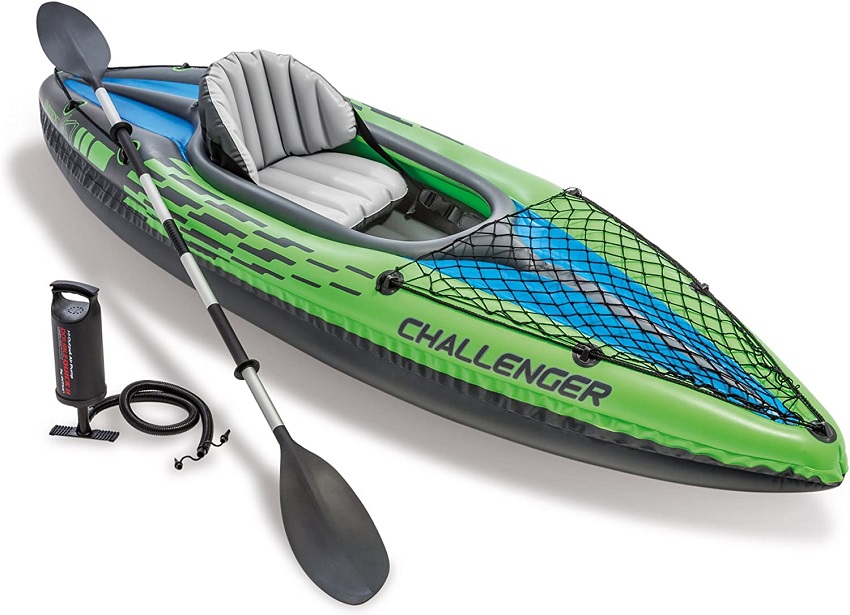
Length: 9’ (274 cm)
Width: 30 in. (76 cm)
Weight: 27.2 lbs. (12.7 kg)
Weight capacity: 220 lbs. (100 kg)
Construction: Welded PVC
If you’ve got teenagers or kids and want to keep their kayak super cheap, the Intex Challenger is definitely the smart pick. At under $100 (if you find a deal), it’s a great budget-friendly option that makes a good intro kayak for first-timers or youths who aren’t certain they want to take up kayaking. Despite the affordable price tag, though, it’s still sturdy enough to provide many years of use.
The Intex Challenger is a sluggish but incredibly stable kayak, one well-suited to newbies who are just getting their paddles wet. It’s built for lakes and slow-moving rivers, with high primary stability that will keep you paddling easily on any flat, calm water. Thanks to the roomy cockpit and soft inflatable seat, you’ll be comfortable all day long. The front netting also provides you ample space to bring snacks, water, and critical gear.
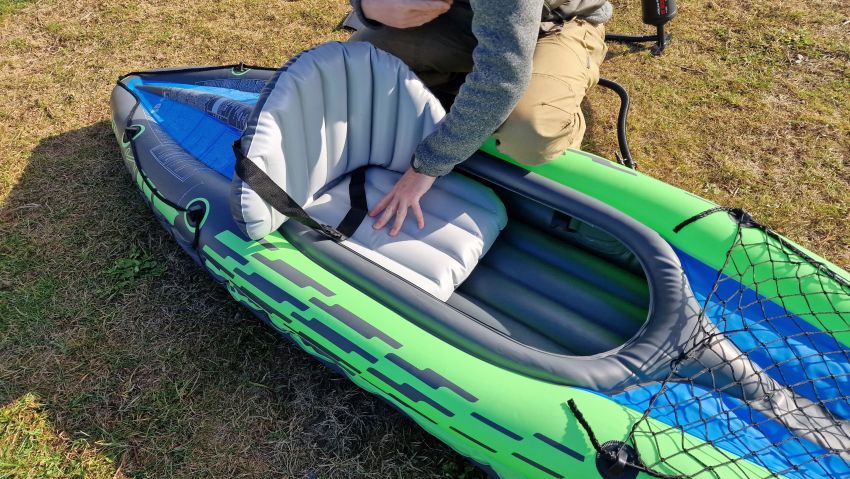
The welded PVC hull is about as tough as you’d expect for a budget-priced kayak, but the paddles are sturdy and the I-beam floors ensure good stability. The kayak even comes with a skeg (removable for easy storage) that keeps it tracking straight.
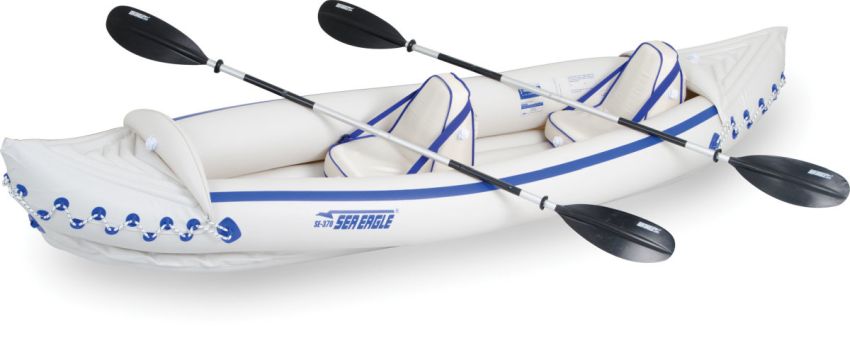
Length: 12 ft. 6 in. (381 cm)
Width: 33.8 in. (86 cm)
Weight: 33 lbs. (15 kg)
Weight capacity: 650 lb. (295 kg)
Construction: Proprietary 38 mil Polykrylar K80
Looking for a sturdier tandem kayak capable of handling more active adventures? Then the Sea Eagle 370 Pro is the choice for you!
The kayak is built insanely tough, using Sea Eagle’s proprietary 38 mil Polykrylar K80, which makes it light but incredibly sturdy and resistant to punctures, abrasions, and impacts. In fact, it’s even useful for whitewater kayaking—it’s rated for up to Class III rapids—and can handle fast-flowing rivers and choppy ocean waves like a boss.
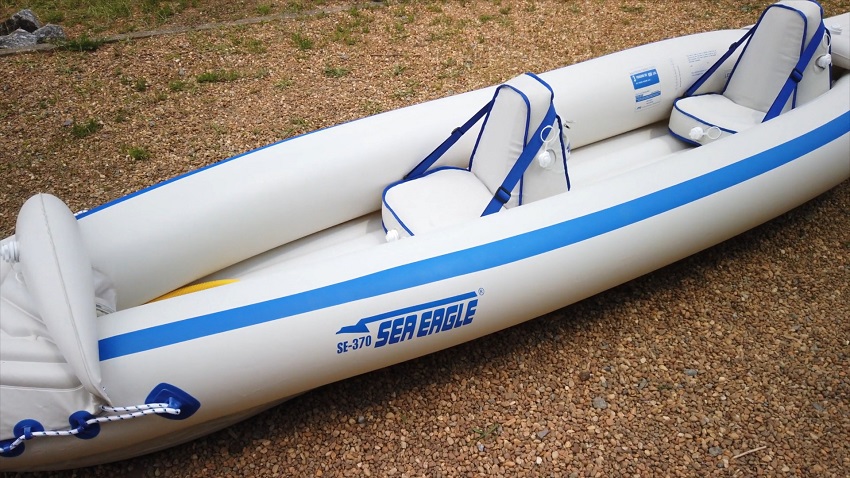
The kayak is a tandem, designed for two people, but it can technically fit 3 people (one without a seat), so it’s great for your entire family or if you want to carry a pet with you. The two skegs on the underside keep it tracking straight and improve handling significantly compared to other inflatables. There’s also built-in drain valves that make it a self-bailing kayak. Thanks to the load capacity of 650 pounds, you’ve got options to take all the gear you want to carry along with you.
Best Single Recreational: Intex Excursion Pro K1
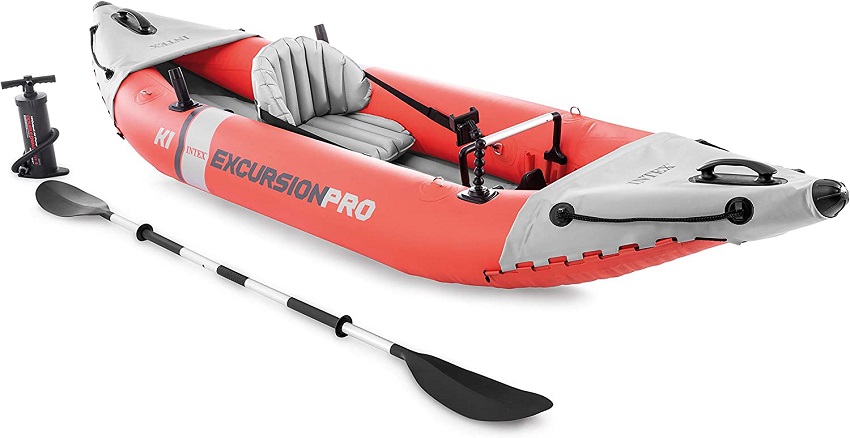
Length: 10’ (304 cm)
Width: 36 in. (91 cm)
Weight: 37.29 lbs. (17 kg)
Weight Capacity: 220 lbs. (100 kg)
Construction: Laminate PVC with polyester core
If you’re a solo paddler looking for an inexpensive, versatile, highly portable kayak, Intex has got the perfect choice for you. The K1 is a single kayak built specifically for recreational paddling, but it can be used for fishing, navigating rivers, or even enjoying a paddle just off the seashore. The high-molecular PVC is multi-layered and laminated around a polyester core, ensuring that it’s tough enough to handle UV radiation, impacts, and abrasion like a boss.
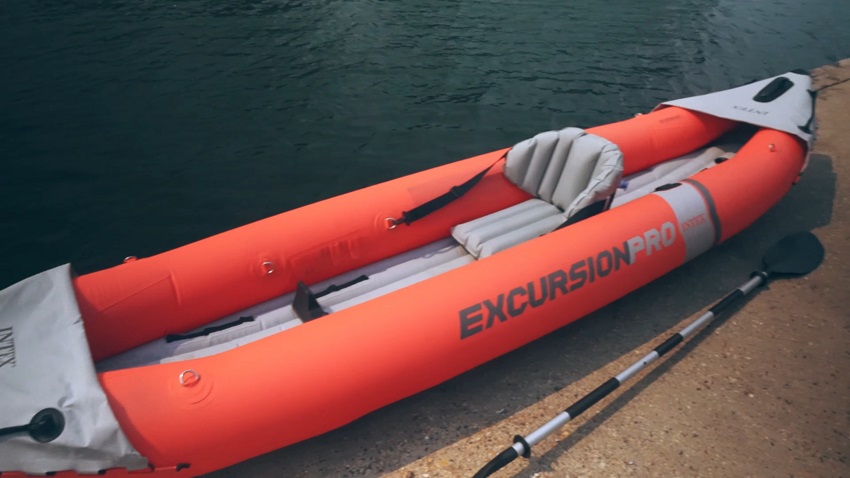
The kayak comes with a surprising amount of storage space (in both the stern and bow), plus stainless steel D-rings that enable you to secure your gear and bags in place while paddling. The grab handles on the ends make it easy to transport, and it even comes with built-in fishing rod holders if you want to cast out a line while floating. The bucket seat is adjustable and even includes a booster pad that elevates you for easier steering and navigation.
Though it has a lower-than-average weight capacity for an inflatable kayak, it’s a great choice to consider if you want to get your solo paddle on and don’t need to carry a lot of gear.
(Note: It’s also available in a tandem model, the K2.)
Best for Fishing: Aquaglide Blackfoot Angler 130
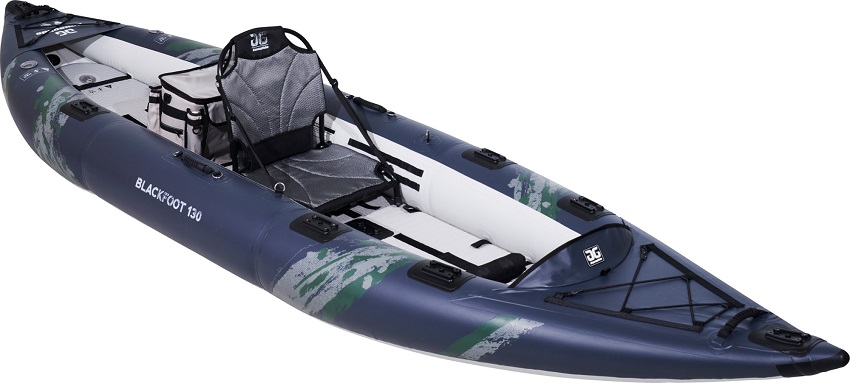
Length: 13’ (396 cm)
Width: 38″ (96.52 cm)
Weight: 41 lbs. (18.6 kg)
Weight Capacity: 650 lbs. (295 kg)
Construction: High-pressure Duratex-reinforced PVC with drop-stitch floor
Anglers, this is the inflatable kayak for you! It’s definitely on the pricier side, but well worth the investment if you want an ultra-portable and reliable inflatable kayak you can take anywhere the fish are biting.
The kayak is built from high-pressure Duratex-reinforced PVC and features a drop-stitch highly rigid floor that maximizes stability so you can fish standing up. It will feel a bit like standing on a paddleboard, and you’ll have little trouble keeping your balance as you cast out or reel in your line. Thanks to the built-in scuppers, the kayak is self-bailing and will stay dry even if the wind or water kicks up.
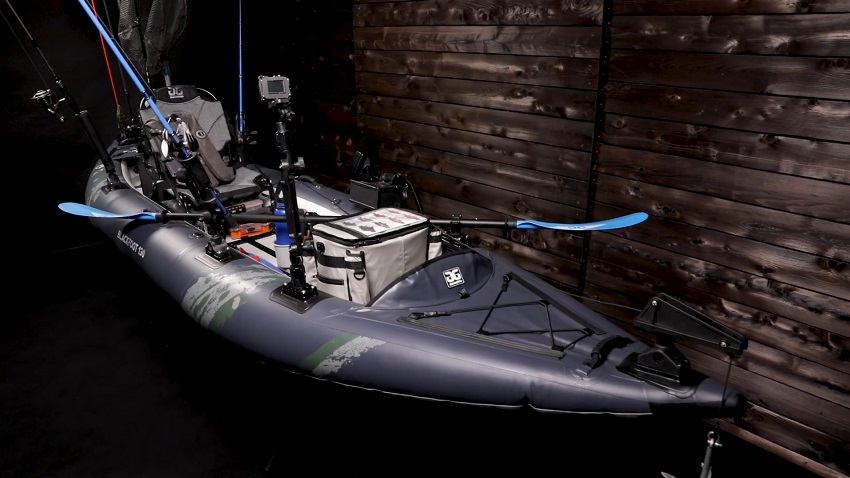
The kayak is packed with angler-friendly features, including 2 MOLLE plates on the side tubes, 2 MOLLE mesh pockets, 20 webbing loops, 6 universal mounting plates, an all-day comfort seat frame with two seating positions, under-the-seat storage, a soft cooler with built-in rod holders, and a heavy-duty nose cone to keep the kayak protected against impact.
Pros:
- Ultra-tough, take it into even narrow, shallow rivers and creeks
- Designed specifically for anglers
- Very versatile—use it standing up or sitting down
- Lots of built-in storage and features
Cons:
- Pricey
- As heavy as a hardshell kayak
Best Tandem Fishing: Elkton Outdoors Cormorant
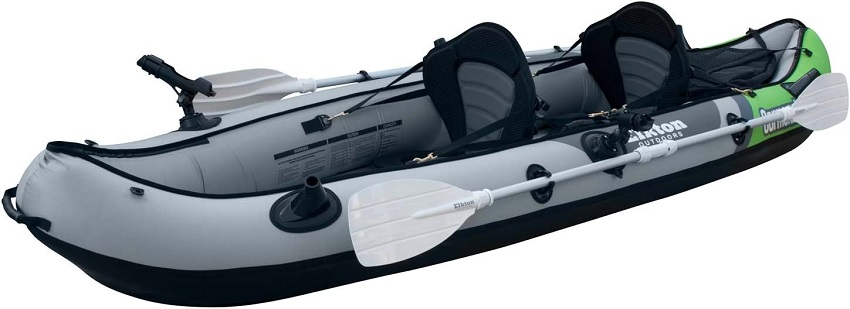
Length: 10’ (305 cm)
Width: 35 ” (89 cm)
Weight: 27 lbs. (12.2 kg)
Weight Capacity: 450 lbs. (204 kg)
Construction: 18-Gauge rip-resistant 1000D PVC
Next time you plan to take a buddy fishing, you’ll be glad you’ve got this kayak! Built specifically for two users, the tandem kayak is designed to inflate in minutes, hold its shape and pressure all day long, and keep you comfortable for hours of fishing.
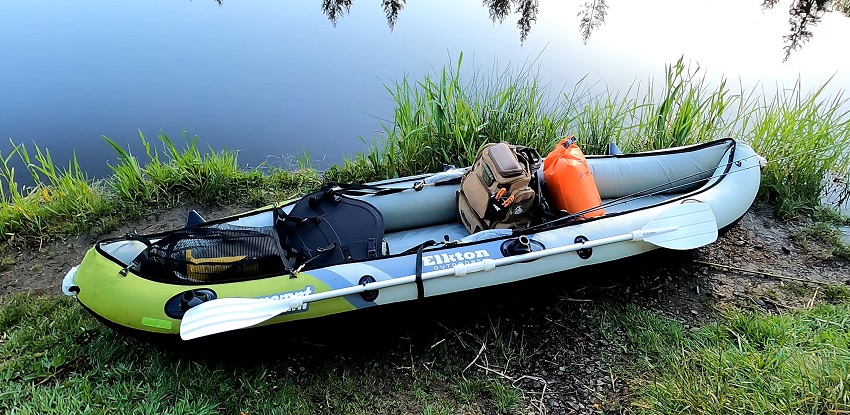
The hull is made from 18-Gauge rip-resistant 1000D PVC, and it’s resistant to damage from underwater obstacles, impacts, collisions, and even errant fishing hooks. In addition to the kayak’s two comfortable adjustable seats, the package includes six rod holders (four trolling, two vertical), two sets of double-sided oars, a double action pump, a removable skeg, and a carrying bag that makes it easy to transport the kayak to and from the water.
The mesh storage compartment on the front of the kayak provides extra space to stash your gear or clothing, and straps down so you never have to worry about losing anything even if you tip over. Not that you will tip over—this kayak is insanely stable, designed for two grown men to fish standing up without so much as a wobble. All in all, a kayak angler’s best friend!
Pros:
- Ultra-stable and sturdy construction
- Includes plenty of rod holders and storage space
- Fish standing up or sitting down (in two positions, thanks to the adjustable seat)
- Affordable mid-range price
Cons:
- Heavy
- Rear seat doesn’t provide enough legroom for taller kayakers
Best Kayak / SUP Hybrid: ISLE Switch
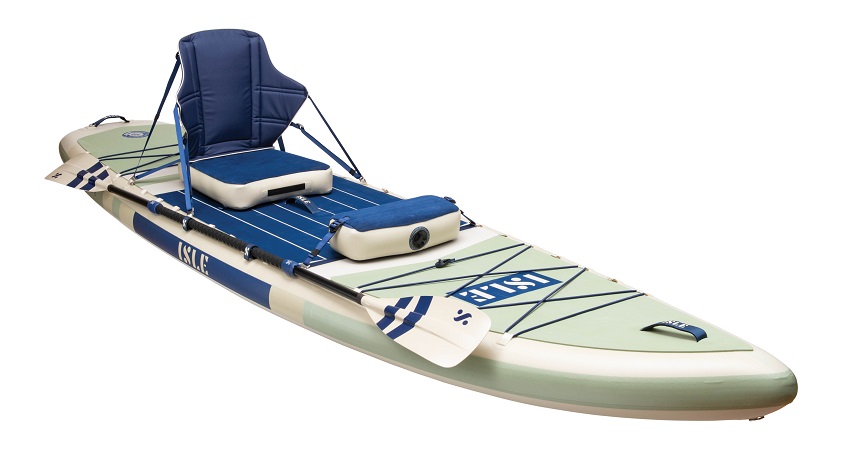
Length: 11’ 6” (350.5 cm)
Width: 35.5″ (90 cm)
Weight: 19 lbs. (8.6 kg)
Weight Capacity: 425 lbs. (193 kg)
Construction: Unspecified synthetic material reinforced using drop-stitching
“Hybrids” are essentially paddleboards that can be used as kayaks, or kayaks that can be used as paddleboards. The Isle Switch is one I’ve personally tested and absolutely LOVE! Not only is it insanely stable, but it’s hyper-tough and able to withstand a lot of hardcore use. Plus, the high weight capacity (425 pounds) means a heavy guy like me can still carry 100+ pounds of gear and still not push the board to its limits.

Though it’s built like a paddleboard—complete with EVA padded footboard and grab handle in the center of the board—you can attach the inflatable, adjustable seat and footbed anywhere you want thanks to the ISLE-LINK webbing loops. You can paddle it solo or bring a rider with you (in my case, my 5’3” wife), and the board can more than handle the weight.
Thanks to the 6-point front bungee, you’ve got storage space enough for a dry bag or cooler, and the 4-point rear bungee gives you a bit more room to carry gear. The board even comes with a paddle holder, where you can store the removable paddle heads—great for easily switching between paddleboard and kayak and back again!
Pros:
- Insanely versatile—use it as both a paddleboard and kayak
- Comfortable, sturdy, and very stable
- Built tough, and backed by a 2-year warranty
- Very lightweight—just 19 pounds!
Cons:
- Pricey by comparison to the “budget” models
Best for the Beach: ADVANCED ELEMENTS Lagoon 1
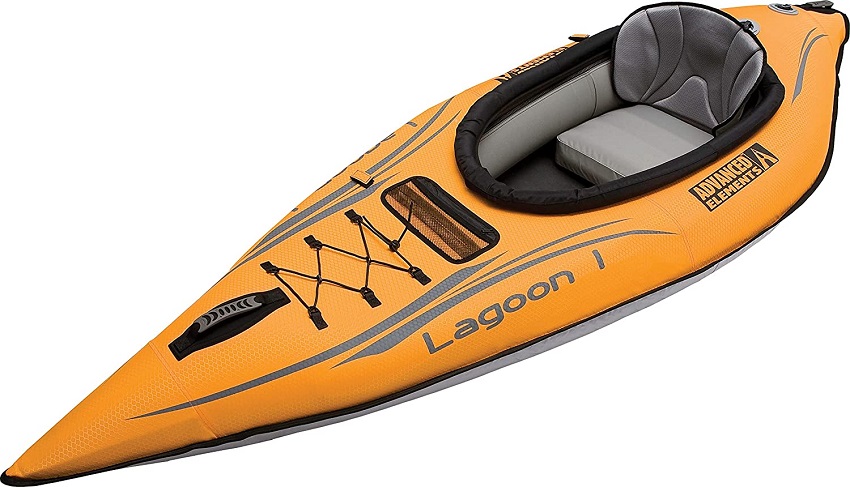
Length: 8’ 4” (254 cm)
Width: 34 in. (87 cm)
Weight: 23 lbs. (10 kg)
Weight Capacity: 250 lbs. (113 kg)
Construction: Rip-stop Polyester and PVC Tarpaulin
If you want a compact, zippy kayak capable of handling waves and ocean swells, the Advanced Elements Lagoon 1 definitely fits the bill. Though it’s short, just over 8 feet long, it’s got excellent secondary stability so it will stay upright and gliding forward even on the choppiest of waters. At just 23 pounds, it’s lightweight enough you can take it anywhere and even let your kids use it off the beach.
The boat is made from a mix of rip-stop Polyester and PVC tarpaulin layered atop each other, forming a strong hull that is reinforced to be both tough and rigid enough to slice through waves. It’s got surprisingly good handling and tracking for an inflatable, with a tracking fin to enhance maneuverability and keep you on course even when the waves are up.
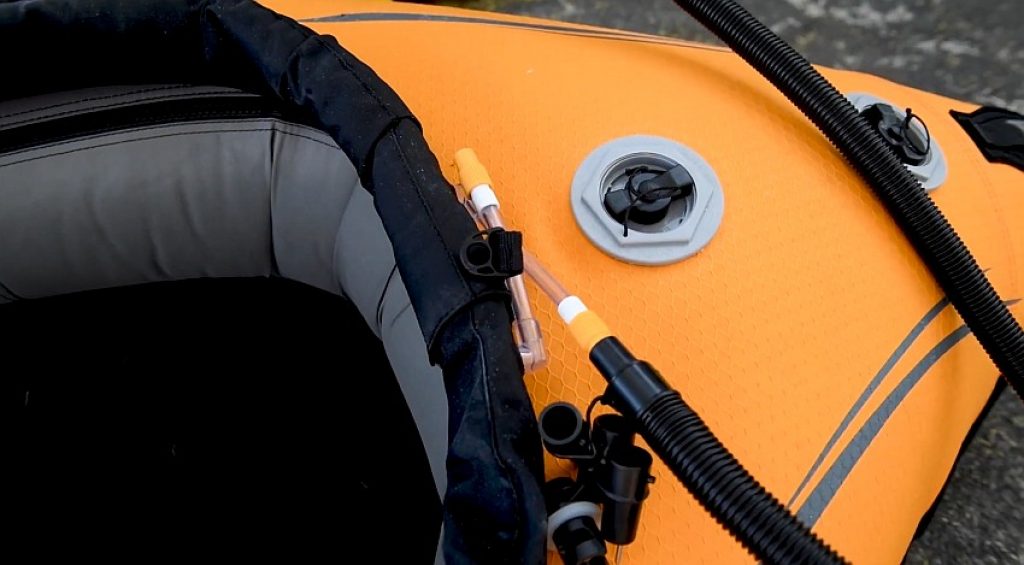
The foam floor is comfortable for your feet and legs, and the paddle loops give you a convenient out-of-the-way place to keep your paddle when you just want to drift along. Though the seat could be better and the cockpit isn’t too roomy for people with long legs, it’s still a great choice for anyone who wants to enjoy some sea kayaking.
Best Sit-on-Top: Sevylor Quikpak K1
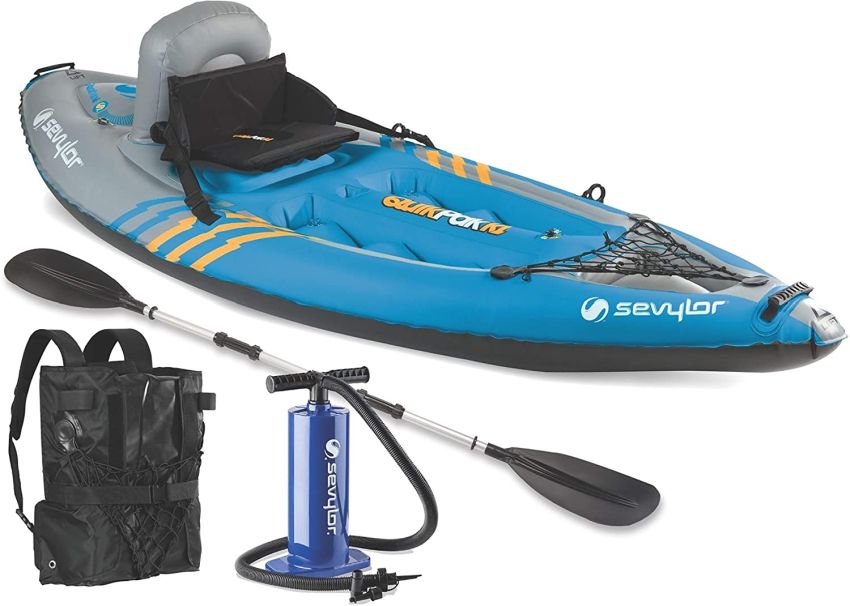
Length: 8’7” (262 cm)
Width: 3’ (91 cm)
Weight: 18 lb (8 kg)
Weight Capacity: 400 lb (181 kg)
Construction: 21-gauge PVC with a tarpaulin bottom
For those who prefer the sit-on-top style of kayak, this is the pick for you. It’s got a very high weight capacity—up to 400 pounds—so even though it’s not the longest kayak on our list, it’s more than capable of handling bigger and heavier paddlers.
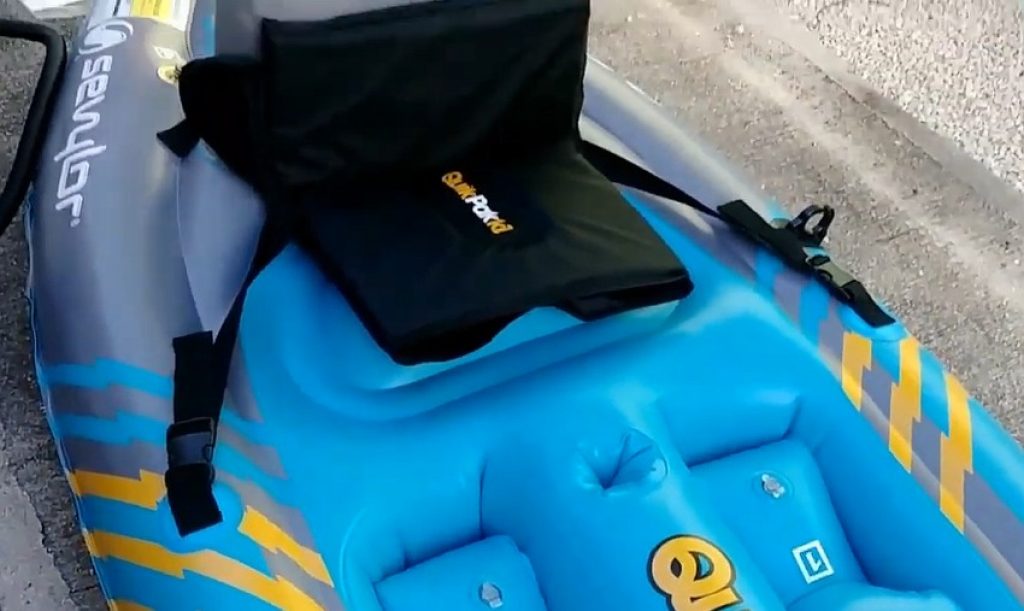
It feels and handles like your standard sit-on-top kayak, with only a fraction more sluggishness considering how high it rides on top of the water. The 21-gauge PVC hull is more than tough enough for all your daily use (or kids’ rough handling), and the bottom is reinforced with tarpaulin to ensure it’s not damaged if you drag or scrape it. The three-chamber design and rigid bottom keep it stable and maintain the shape so you have a solid platform to sit and even stand on.
When the time comes to pack up, you’ll find it deflates easily and folds down quickly—the perfect ultra-portable solution.
Pros:
- Sit-on-top design is roomy and spacious
- Good weight capacity; can easily handle larger users
- Compact, lightweight, and very portable
- Great price tag
Cons:
- The paddle isn’t great—you’re recommended to buy your own separately
- No storage provided
- Doesn’t track straight. No skeg provided
Inflatable Kayak Buying Guide: Factors to Consider
Solo or Tandem?
The number of seats is always the first factor to consider. Why, you ask? Simple: a 1-person kayak can’t hold two (adult) paddlers at once, and a tandem or 3-person kayak may be too big/unwieldy for a single paddler to handle alone.
If you’re the only one in your family who wants to try kayaking, stick with a 1-person (solo) kayak. If others show interest later on, you can A) lend them the kayak, or B) buy another for them to use.
However, for couples or families who want to paddle together, multi-person kayaks can be the way to go. Tandem kayaks allow two paddlers to sit in the kayak at once, and there are even kayaks with 3 seats capable of supporting the weight of three adult paddlers.
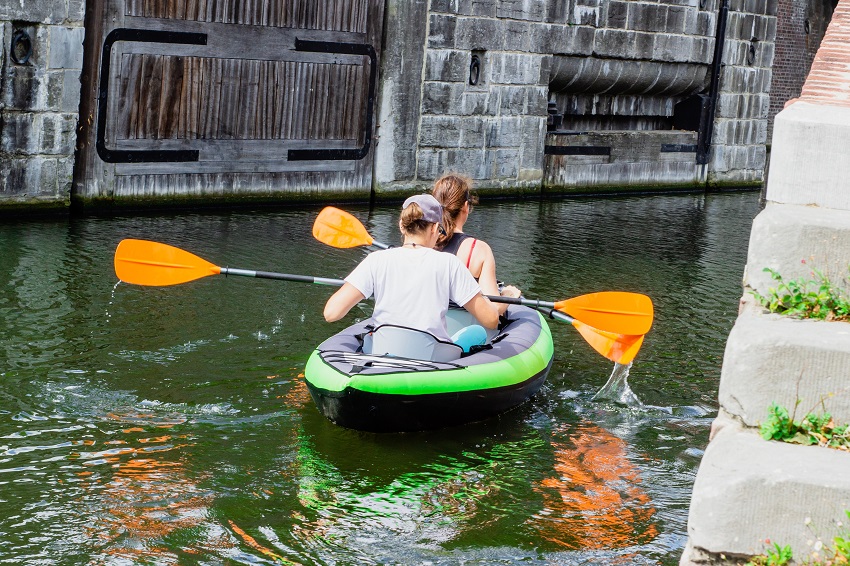
For adults who want to kayak with their kids, there are single kayaks that can be paddled by one person, but have room enough to accommodate a smaller passenger. Or, if your kid is old enough, consider a tandem kayak so they can help you paddle and learn the basics of kayaking.
What about if you want to take your dog paddling with you? Some single kayaks have room enough for your pet to sit, but big dogs may require a tandem kayak.
Bonus: Not sure? Try a convertible kayak! There are some (very few) kayaks that are “convertible”, which means they can be switched between 1- and 2-person use. These are a great option for anyone who thinks they may want to bring out their pet, spouse, or kids on the water, but will likely spend a lot of time kayaking solo.
What Are Inflatable Kayaks Made From?
There are several materials that inflatable kayaks can be made of, each of which has its own advantages.
PVC
Probably the most commonly used material, and certainly the cheapest, is PVC. PVC can be more easily mass produced than other materials, so may suffer from some quality issues, although that’s more common in the rafting world than kayaks.
It may be cheap, but PVC is still relatively durable, although is more susceptible to temperature change and UV damage than other materials. Bear this in mind if you’re rolling it up on cold days or thinking about where to store your boat.
PVC has become almost a taboo word in an increasingly environmentally aware world and allegedly the fabric secretes chemicals over time as it degrades.
Hypalon
Hypalon is a synthetic rubber which is particularly noteworthy for its resistance to chemicals, temperatures and UV damage, meaning you’re less likely to return to your stored boat to find it’s perished.
Hypalon is more expensive than PVC. However, it is easy to repair on the go and is more pliable than PVC, which makes these kayaks much easier to roll up at the end of the day, especially when it’s cold outside.
Hypalon boats are often glued at the seams, rather than being plastic welded, so there’s a chance of them peeling and coming apart at the seams. This necessity to be glued makes these boats harder to repair, especially if you’re out on the water or an expedition.
Nitrylon
Nitrylon is a lamination of natural and synthetic rubber over a 1200 denier, low stretch polyester. This design makes it much more environmentally friendly than PVC designs, while also being incredibly strong and hard wearing.
Nitrylon is puncture- and abrasion-resistant and known to last an incredibly long time. However, the layered design makes it much heavier than its counterparts. Because of this, it’s more commonly used on larger boats than kayaks and even then, mainly as resistant patches or on external sections which require more protection.
TPU (Thermoplastic Polyurethane)
TPU is the most progressive, and therefore the most expensive, material in inflatable kayak production.
Firstly, the seams on a TPU design can be welded, rather than glued. As well as making them more durable and longer lasting, this means the boat can be pumped up to a higher pressure. In turn, this means boats can be narrower and given more shape, leading to a more progressive level of design.
TPU is more robust and abrasion resistant than other materials. It also withstands temperature change even better than Hypalon. This extra strength and welded seams mean that TPU doesn’t need to be as thick as other materials, so TPU boats are usually lighter and easy to roll up for transportation.
Different Types of Inflatable Kayaks
Similar to how traditional kayaks come in many varied forms, inflatable kayaks have branched out from recreational designs and, as technology advances, are increasingly competing with rigid designs.
Sit-on-Top or Sit-Inside Kayaks
In the world of plastic boats, the majority of designs have traditionally been closed cockpit, sit-inside boats which use a spray deck to keep water out. Recreational kayaks and increasingly more progressive designs, however, have been moving into the realms of sit-on-top kayaks, with sea kayaks, surf boats and even white water playboats available now in sit-on versions.
In the worlds of inflatables, however, the roles are somewhat reversed. Inflatables were born of designs similar to traditional dinghies; wide, open boats. While material and design have allowed for narrower and more directional boats to be made, they are often still open top designs, although increasing numbers of boats are offering spray skirt options.
It’s not always obvious when you look at an inflatable kayak whether it’s sit-on or sit-in. The differences are more subtle than in plastic designs.
Sit-in kayaks tend to offer some coverage, whether it’s as extensive as a full surround and cockpit design, or a simple leg covering incorporated into the design. The primary aim here is to keep out as much water as possible and these are often used in more challenging environments such as the sea or on rivers.
Some sit-on-top kayaks could be easily confused for sit-in boats. The narrow seating area is often surrounded by high inflatable tubes, which keep out almost as much water as any skirt might.
As paddle board design has progressed, sit-on-top inflatable kayaks are progressing towards a similar model, with many manufacturers offering seating options for inflatable, recreational paddle boards. These are particularly good for relaxed trips, cruising around gentle waterways or on hot days, but may be limited when it comes to progressive attributes.
Recreational Kayaks
Recreational kayaks tend to be among the cheapest, easiest to paddle and most stable options on the market. They’re designed to give everyone a chance to take to the water and whether they’re sit-inside or sit-on-top design, tend to have large buoyancy chambers all around.
They are often long, relatively flat designs without much rocker. The seating is usually basic, designed to be relatively comfortable and lightweight enough that these kayaks can be transported easily.
Recreational kayaks are perfect for those just starting the sport, for families, or for anyone that wants to stay on calm water and enjoy a leisurely day out.
Fishing Kayaks
Inflatable kayaks designed for fishing tend to fall, first and foremost, into one of the other categories. You can get fishing-recreational kayaks, fishing-touring/sea kayaks, or fishing river kayaks. What sets these boats apart is their fishing-friendly extras, like storage space, rod holders and higher seating. There can also be mounts for fishing tech, and a skeg or keel to help the boat track. These features take the boat from a fishing-capable to a fishing-specific kayak, perfect for any angler.
The incredible stability of inflatable kayaks means they lend themselves excellently to fishing; many of them are already perfectly adequate for standing in. Being so versatile and easy to transport makes inflatable kayaks perfect for fishing. They can be rolled up and carried to almost any body of water.
Touring/Sea Kayaks
Paddling an inflatable kayak in the sea or on long touring expeditions can be an incredible experience. The lightweight design means you have to expend less effort to propel the boat. However, as we’re getting into more technical realms, inflatables may not quite be challenging at the forefront of design just yet.
There are many recreational inflatable kayaks which are sold as being sea going, however these are usually open design and unsuited to longer distances. There are a number of closed cockpit style inflatable kayaks which are perfect for trips on open water and are designed to crash through waves.
Here, the TPU design and higher pressure chambers give the boat more structure and shape, while some designs have rigid interior frames which can even add some fairly competitive keel lines.
RELATED: Best Touring Kayaks for 2023: Reviews and Buying Tips
Outfitting is much more basic than in solid counterparts, but the seating in sea kayaks is usually designed to be much more supportive and comfortable than in recreational boats, and some even come with foot rests, which allow you to drive the boat more effectively.
It’s worth being aware that the lightweight design of inflatable kayaks generally makes them harder to control in the wind and more likely to get caught up in drifts than plastic boats.
Whitewater Kayaks
White water kayaks traditionally have a good amount of bow rocker and a relatively flat hull, so it’s hardly a surprise that inflatables took to white water so well. White water rafting has been a popular sport around the world for many years. As inflatables have become stronger and less likely to puncture, inflatable kayaks have seen a surge in popularity.
As well as the additional rocker, these boats often tend to be narrower, slightly lower profile and have outfitting designed to maximise your control. A supportive and connective backrest, foot rests for driving the boat and often thigh braces, secured with glued D-rings, offer about as much control as you could expect from an inflatable boat.
Being so stable and confidence inspiring, inflatable kayaks are increasingly used to take beginners on the river and are even perfect for multi-day white water trips on some gnarly rapids. Usually these boats are open design.
Packrafts
There was a gap in the market, and inflatables filled the void. Packrafts are not necessarily a category of their own; they can be recreational, ocean going, rapid running or a combination of all of these. They took the idea of lightweight and portable kayaks and ran with it to create the ultimate adventure add-on.
These are simple designs, usually with no seat, and are designed to augment a trip. They were popularised by mountain bikers looking for a way to cross larger bodies of water, and are now used across the world.
The lightest models weigh as little as 2lb 3oz (1kg) and are perfect to take in a bag, inflate and cross a lake or navigate a river before taking to the land again.
Packrafts often have spray skirts, as well as clever gear storage options which range from d-rings to secure your kit in front of you, to airtight zips so you can store your kit in the body of the boat itself and paddle in freedom.
These boats are worth checking out as part of a wider adventure, rather than a specific kayak trip.
Construction
In addition to the material used for the hull and cockpit, there are a number of ways manufacturers can increase the durability of their inflatable kayaks.
Taping or reinforcing the seams, for example, will prevent leakage. Typically, extra-tough materials are bonded to the hull at the seams/tear points, which adds another layer of protection and durability.
Drop-stitching is a modern technique used in the building of extra-sturdy kayaks and paddleboards. Multiple sheets of synthetic fabric (like PVC, nylon, or Hypalon) are joined together by hundreds (or thousands) of threads. This joining makes them incredibly tough and resistant to damage, and provides a stiff bracing to support inflation to high air pressure (such as the 15 PSI recommended for paddleboards). Drop-stitched kayaks tend to be much tougher, stiffer, and more durable, but still offer all the benefits of regular inflatable kayaks—albeit at a heavier weight and a higher price.
Multiple chambers help to keep the kayak from being deflated if one part gets damaged. For example, if a branch punctures the bottom hull, the chambers that serve as the “side hulls” remain undamaged and inflated, so you can safely paddle back to shore. Most modern inflatable kayaks will feature a multi-chamber design.
Weight Capacity
Weight capacity is definitely something to think about if A) you’re bigger and heavier (like me), B) you plan to take multiple passengers (spouse/partner, pet, child, or buddy) kayaking with you, or C) you want to transport a lot of gear.
Because inflatable kayaks are (literally) filled with air, they have a significantly higher buoyancy than hardshell kayaks. The fact that the kayak materials are also insanely lightweight helps, too—after all, the empty kayak will be sitting on top of the water with very little to weigh it down.
Even the “budget” inflatable kayaks can have a weight capacity as high as 350 or 400 pounds, with some of the mid-range or higher-end models rising as high as 600 pounds or more.
Weight
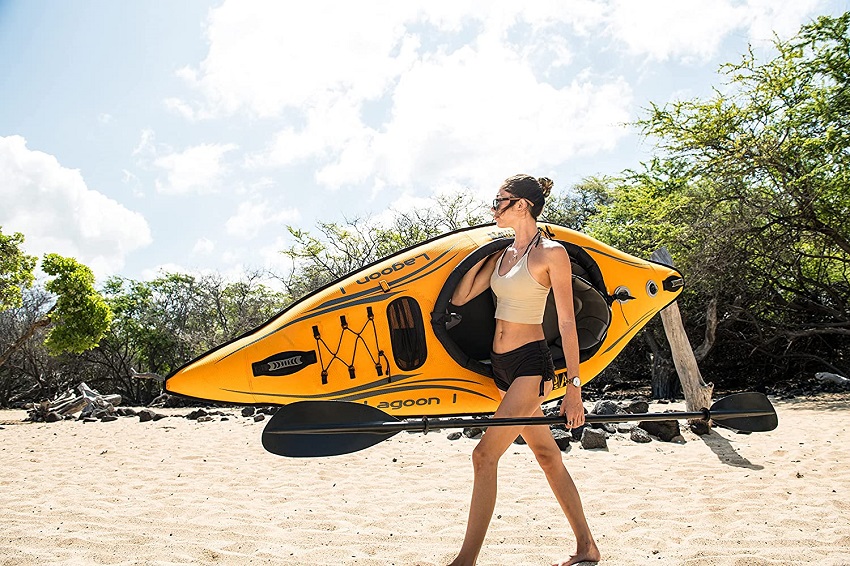
Hardshell kayaks—even ones made using “lighter” materials like fiberglass—tend to be on the heavier side.
Take Pelican’s Mustang 100X, one of the lightest recreational kayaks on the market. It’s definitely not insanely heavy at 39 pounds, but can you imagine trying to lug around that kayak alone, across long distances, filled with water, and trying to load it onto your roof rack? Not an easy day, and that’s the light one! The Lifetime Tamarack Pro 103, which we rated as our top pick in the Best Fishing Kayaks article, clocks in at 57.5 pounds. Talk about heavy!
On the other hand, an inflatable kayak is exponentially lighter. Our “budget” model, the Intex Challenger, weighs around 25 pounds, a weight even young kids can more than handle on their own.
Length
Typically, the average recreational kayak is around 10 feet long. For kids, that length is around 8 feet. Fishing kayaks will be in the 10 to 12-foot range, and sea touring and expedition kayaks will be anywhere from 12 to 16 feet.
Imagine trying to fit that on top of your sedan, or into the back of your compact truck. Not gonna happen!
And that’s where inflatable kayaks come in handy. You can choose whatever length works best for you—shorter for lightweight and more agile, longer for greater stability and easier handling—and the size won’t matter because when it’s deflated, it will fit back into its storage bag and in the trunk of your car, van, or SUV.
Design
Not all kayaks are built the same. Typically, they’re constructed according to their design:
- Fishing kayaks tend to be wider, slower, and more stable so you can carry more fishing gear and even fish standing up
- Recreational kayaks are lighter and easier to handle
- Sea/ocean kayaks are built for higher secondary stability, more weight capacity, and faster speeds to cover long distances
- Whitewater kayaks are typically built squat and tough, with excellent handling but poor primary stability
Finding the right inflatable kayak design based on the activity you’ll be engaged in is always the smart way to go!
Accessories
Most inflatable kayaks come with all the critical accessories—including a seat, paddles, and hand pump—needed to get you out on the water.
However, it’s worth taking a close look at exactly which accessories are included in the package. Some will offer better-quality and more durable items, while others will include items so cheap/poor quality that you’ll spend more to replace them.
Price
Last, but definitely not least, you’ll want to consider the price of the inflatable kayak.
As you’ll see on our list below, inflatable kayaks tend to be significantly cheaper than hardshell kayaks. The highest-end inflatables will often run you about the same as a mid-range hardshell, depending on design and construction.
However, just because they’re more budget-friendly, that doesn’t make them all “cheap” in terms of quality. It’s worth looking at all the specs (chiefly the material used and construction features that add durability), because it may be worth paying a slightly higher price to get a significantly sturdier and more user-friendly kayak.
How to Extend Your Inflatable Kayak’s Lifespan
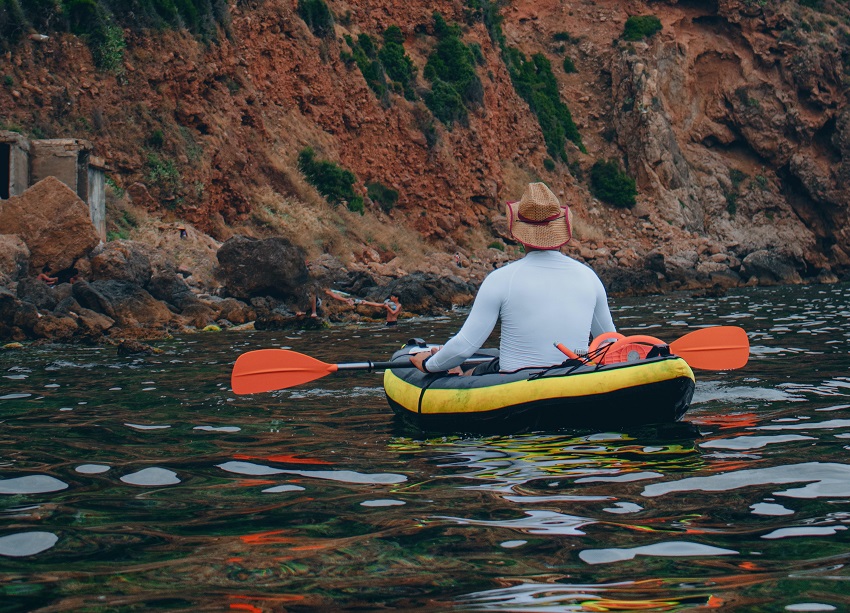
As you saw above, inflatable kayaks tend to be more easily damaged than hardshell kayaks, and can never truly match the durability of a hardshell.
However, there are still plenty of ways you can extend the lifespan of the inflatable kayak, a few simple habits to build that will go a long way toward protecting it from damage:
- Never drag it. You may drag it (unknowingly) over rocks, gravel, tree roots, or debris that could puncture the hull. Even just dragging it will scrape the hull, and over time, repeated abrasion can weaken the fabric. Thankfully, most inflatable kayaks are light enough you can easily carry them.
- Fill each chamber to the right pressure levels. Underfilling the kayak can cause it to sag, bend, and sink. Overfilling the kayak can strain the chambers and increase the risk of damage from within. Follow the instructions displayed plainly on the kayak (and included in the manual/on the box) and make sure to fill each chamber to the proper PSI.
- Load your kayak as evenly as possible. It’s understood that with tandem kayaks, the weight distribution may be uneven if you’re paddling an adult and child, or an adult and a pet, or even two adults of different sizes (look at my 5’3” wife and my 6’6” self, and you’ll understand). However, you should still spread out any gear you’re carrying so the weight is distributed as evenly as possible. This will not only keep the kayak from tipping, but prevent excessive load being placed on a specific part of the kayak, which could lead to damage, tears, or punctures.
- Be aware of obstacles and objects. If you’re paddling near the shore or in shallower waters (such as an inlet, creek, or river), be aware of any underwater objects or obstacles that could puncture or tear your kayak. Steer well clear of anything you even suspect might come close enough to the surface to damage your kayak. Avoid collisions and impacts as much as possible.
- Dry your kayak thoroughly. Once you’re done paddling for the day, take a few minutes to wipe the kayak down with a towel. Leave it out in the sunlight afterward for 5 minutes to ensure it’s as dry as possible. Only then should you put it away, once you know it’s bone dry. PVC is prone to mold and mildew, which could weaken the kayak over time.
- Don’t leave the kayak out in the sun for too long. Sunlight and UV radiation can damage PVC, nylon, and polyester (all synthetic materials used in the kayak’s construction). The kayak will already be spending plenty of time in direct sunlight while you’re out on the water, so when you’re done paddling, make it a point to pack up the kayak as soon as possible. Make sure to store it in a clean, dry, DARK place.
Why Inflatable? Inflatable vs. Hardshell Kayak
I want to take a moment to highlight the things that make the inflatable kayak a suitable option. They may not be the “best” choice for most water sports—I definitely wouldn’t recommend taking them on a sea touring expedition or heading down Class IV rapids—but for the average recreational kayaker or kayak angler, they can be a good choice for a number of reasons.
Advantages of Inflatable Kayaks
They’re lightweight
If you’re a lone individual, you may struggle a bit loading/unloading a hardshell kayak from your vehicle, and again dragging it to and from the water or emptying it after use. Not so with inflatable kayaks. They tend to weigh a grand total of about 20-40 pounds. That’s a weight almost anyone can manage.
They’re compact
If you don’t have a roof rack on your SUV or a truck large enough to transport a kayak or pull a kayak trailer, you’re pretty much out of luck with a hardshell kayak. However, an inflatable kayak needs no rack. Deflated, it folds down to roughly the size of a suitcase, which you can fit into any vehicle.
They’re stable
You’ll rarely struggle to stay afloat in an inflatable kayak (on calm waters). Inflatable kayaks have very high primary stability, which means they’re very steady when the water is flat. If you’re planning on sea kayaking, you can find options with higher secondary stability that can handle choppy water, too. However, thanks to the fact that you’re literally sitting on air, inflatable kayaks tend to have a higher primary stability than hardshell kayaks and thus are much less likely to tip over.
They’re comfortable
Again, you’re sitting on air. There’s no hard or uncomfortable seat beneath your butt, no stiff backrest that never feels quite right. You’ve typically got plenty of room to stretch out, a soft seat, and a comfortable, flexible design.
They tend to have a higher weight capacity
Because they’re lightweight and have a larger volume, they have significantly greater buoyancy than hardshell kayaks. This means they’re capable of supporting far more weight. Some can hold up to 850 pounds (between paddler and gear), which is significantly more than even a sit-on-top hardshell kayak can handle.
They’re newbie-friendly
Inflatable kayaks make it easy for new paddlers to get their feet wet and try their hand at kayaking even with no skill. They’re a bit sluggish to paddle (as you’ll see in the “Cons” section below), but their high primary stability makes them great for those who are still struggling to master the balance and practice the basic paddling strokes.
They’re budget-friendly
This is a HUGE benefit! After all, if you’ve never paddled before, you may not want to dive into the deep end and invest $1,000 into a higher-end kayak right out of the gate. It’s more likely you’ll want to start cheap, and only upgrade once you’re sure you love it. As you’ll see in our list below, some inflatable kayaks tend to cost a fraction of what you’d pay for a regular hardshell kayak. Plus, most come with all the necessary accessories—including paddles, pumps, lines, etc.—so all you need to purchase is a PFD and you’re ready to go!
All pretty great reasons to consider an inflatable kayak, right?
Drawbacks of Inflatable Kayaks
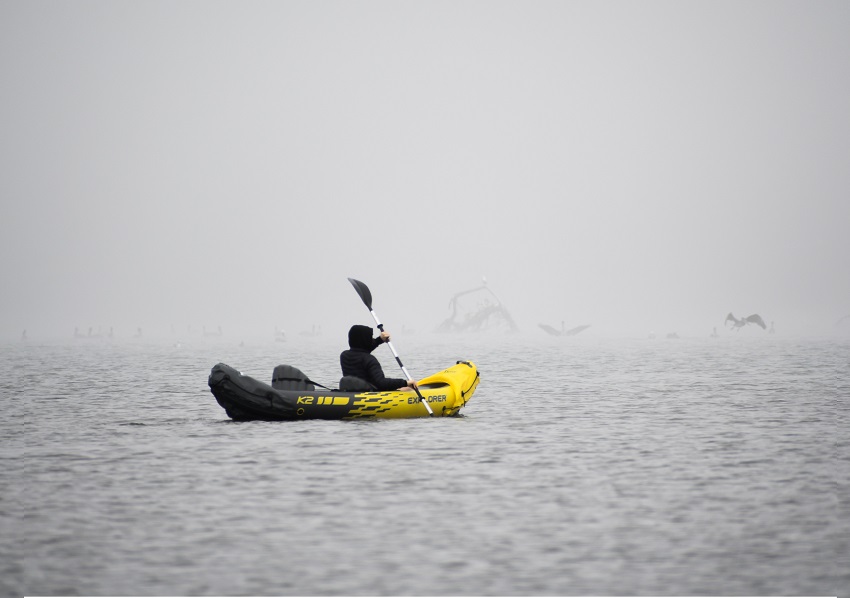
Let’s be honest: no matter how many “pros” the inflatable kayak has, there will always be a couple of “cons”, right?
Here are the drawbacks you need to be aware of:
They’re more time-consuming
Inflating each kayak can take about 5-10 minutes of solid effort pumping. You can cut the effort down significantly with an electric-powered SUP/kayak pump, but it still takes more time to get in and out of the water than with a hardshell kayak.
They’re not as sleek or swift
Inflatable kayaks tend to be a bit more sluggish, less responsive to steering, and require more effort to paddle. Because they sit on top of the water, they can also be blown off-course more easily. They’re also not built for top speed—there are no inflatable racing kayaks. If you’re all about that speed and handling, you’re better off with a hardshell.
They’re not as durable
Don’t get me wrong: the PVC and other materials used to make the kayak’s interior and exterior shell are sturdy enough to handle regular use, even bumps and bangs against rocks and other obstacles, both under the water and above the surface. But there is a risk that sharp rocks or tree branches can puncture the kayak’s hull, or that a harsh impact can scrape the synthetic fabric. An inflatable kayak is also more prone to mold and mildew if you fold it up and store it wet.
They’re not always compatible with spray skirts
This isn’t a HUGE deal during the warm summer months when the water is cooling on a hot day. However, if you’re kayaking in cool or cold water, a spray skirt can go a long way toward keeping you dry and warm. Some inflatable kayaks can be used with spray skirts, but many are designed with an open cockpit that allows water in—and doesn’t always allow it to drain (until you tip it up and drain it manually).
None of these “cons” are deal-breakers, but it’s important that you’re aware of them as you continue to the shopping and selection phase of your search for the best inflatable kayaks.
Inflatable Kayak FAQs
They absolutely are! Thanks to the materials used, the multi-chamber construction, reinforced seams, and high primary stability, inflatable kayaks are incredibly safe to use on most calm, flat waters. In fact, because of their buoyancy, it could be argued they’re even safer than hardshell kayaks.
Getting into the kayak and paddling for your first time, you’d never know the difference between a hardshell or an inflatable kayak. However, as you level up your skills, you’ll find inflatable kayaks handle a bit more sluggishly than hardshell kayaks, and are less responsive for sharp turns.
There are a few select inflatable kayak models that include plugs or drain holes like a regular sit-on-top kayak. However, the majority of the inflatable kayaks on the market will not be self-bailing. If they fill with water, you’ll have to do the work of bailing them out yourself.
You certainly can, for a short while. When you inflate the kayak, the materials are stretched to their capacity. Over time, if the kayak is left inflated, that material can over-stretch, weaken, or even tear. Leaving your kayak inflated for long periods of time will make it more prone to being damaged.
That being said, if you want to leave your kayak inflated overnight (say, you plan to paddle first thing in the morning and don’t want to waste time pumping it up), you won’t damage it. Just make sure you don’t leave it inflated for too long.


